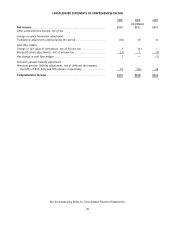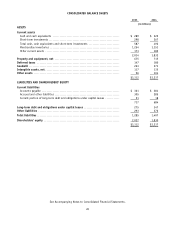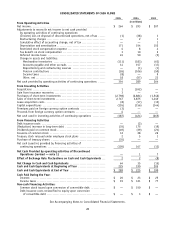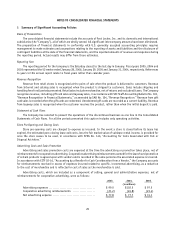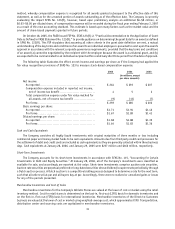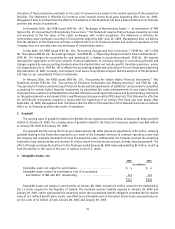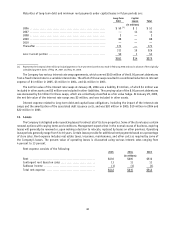Foot Locker 2005 Annual Report Download - page 50
Download and view the complete annual report
Please find page 50 of the 2005 Foot Locker annual report below. You can navigate through the pages in the report by either clicking on the pages listed below, or by using the keyword search tool below to find specific information within the annual report.
allocation of fixed production overheads to the costs of conversions be based on the normal capacity of the production
facilities. The Statement is effective for inventory costs incurred during fiscal years beginning after June 15, 2005.
Management does not believe that the effect of the adoption of this Statement will have a material effect on its financial
position and results of operations.
In December 2004, the FASB issued SFAS No. 153, “Exchanges of Nonmonetary Assets — an amendment of APB
Opinion No. 29, Accounting for Nonmonetary Transactions.” This Statement requires that exchanges should be recorded
and measured at the fair value of the assets exchanged, with certain exceptions. The Statement is effective for
nonmonetary asset exchanges occurring in fiscal periods beginning after June 15, 2005. Management does not believe
that the adoption of this Statement will have a material effect on its financial position and results of operations as the
Company does not currently have any exchanges of nonmonetary assets.
In May 2005, the FASB issued SFAS No. 154, “Accounting Changes and Error Corrections,” (“SFAS No. 154”). SFAS
No. 154 replaces APB No. 20, “Accounting Changes,” and SFAS No. 3, “Reporting Changes in Interim Financial Statements.”
SFAS No. 154 changes the accounting for, and reporting of, a change in accounting principle. SFAS No. 154 requires
retrospective application to the prior period’s financial statements of voluntary changes in accounting principle and
changes required by new accounting standards when the standard does not include specific transition provisions, unless
it is impractical to do so. SFAS No. 154 is effective for accounting changes and corrections of errors in fiscal years beginning
after December 15, 2005. Currently, the Company is not aware of any financial impact that the adoption of this Statement
will have on our consolidated financial statements.
In February 2006, the FASB issued SFAS No. 155, “Accounting for Certain Hybrid Financial Instruments.” This
Statement amends SFAS No. 133, “Accounting for Derivative Instruments and Hedging Activities” and SFAS No. 140,
“Accounting for Transfers and Servicing of Financial Assets and Extinguishments of Liabilities” and provides for simplified
accounting for certain hybrid financial instruments by permitting fair value remeasurement for any hybrid financial
instrument that contains an embedded derivative that otherwise would require bifurcation and by eliminating a restriction
on the passive derivative instruments that a qualifying special-purpose entity (SPE) may hold. This Statement is effective
for all financial instruments acquired or issued after the beginning of an entity’s first fiscal year that begins after
September 15, 2006. Management does not believe that the effect of the adoption of this Statement will have a material
effect on its financial position and results of operations.
2 Goodwill
The carrying value of goodwill related to the Athletic Stores segment was $183 million at January 28, 2006 and $191
million at January 29, 2005. The carrying value of goodwill related to the Direct-to-Customers segment was $80 million
at January 28, 2006 and January 29, 2005.
The goodwill activity during the fiscal year ended January 28, 2006 represents adjustments of $5 million reducing
goodwill relating to the Footaction acquisition as a result of the Company’s decision to continue operating a store that
the Company had originally intended to close at the acquisition date. Additionally, the Company resolved the remaining
Footaction lease related matter and received $1 million return from the escrow account, thereby reducing goodwill. The
effect of foreign exchange fluctuations for the fiscal year ended January 28, 2006 reduced goodwill by $2 million, resulting
from the decline in the value of the euro in relation to the U.S. dollar.
3 Intangible Assets, net
2005 2004
(in millions)
Intangible assets not subject to amortization ............................. $ 4 $ 4
Intangible assets subject to amortization (net of accumulated
amortization of $84 and $70, respectively) ............................. 113 131
$117 $135
Intangible assets not subject to amortization at January 28, 2006, includes $3 million related to the trademark of
the 11 stores acquired in the Republic of Ireland. The minimum pension liability required at January 28, 2006 and
January 29, 2005, which represented the amount by which the accumulated benefit obligation exceeded the fair market
value of U.S. defined benefit plan’s assets, was offset by an intangible asset to the extent of previously unrecognized prior
service costs of $1 million at both January 28, 2006 and January 29, 2005.
34



